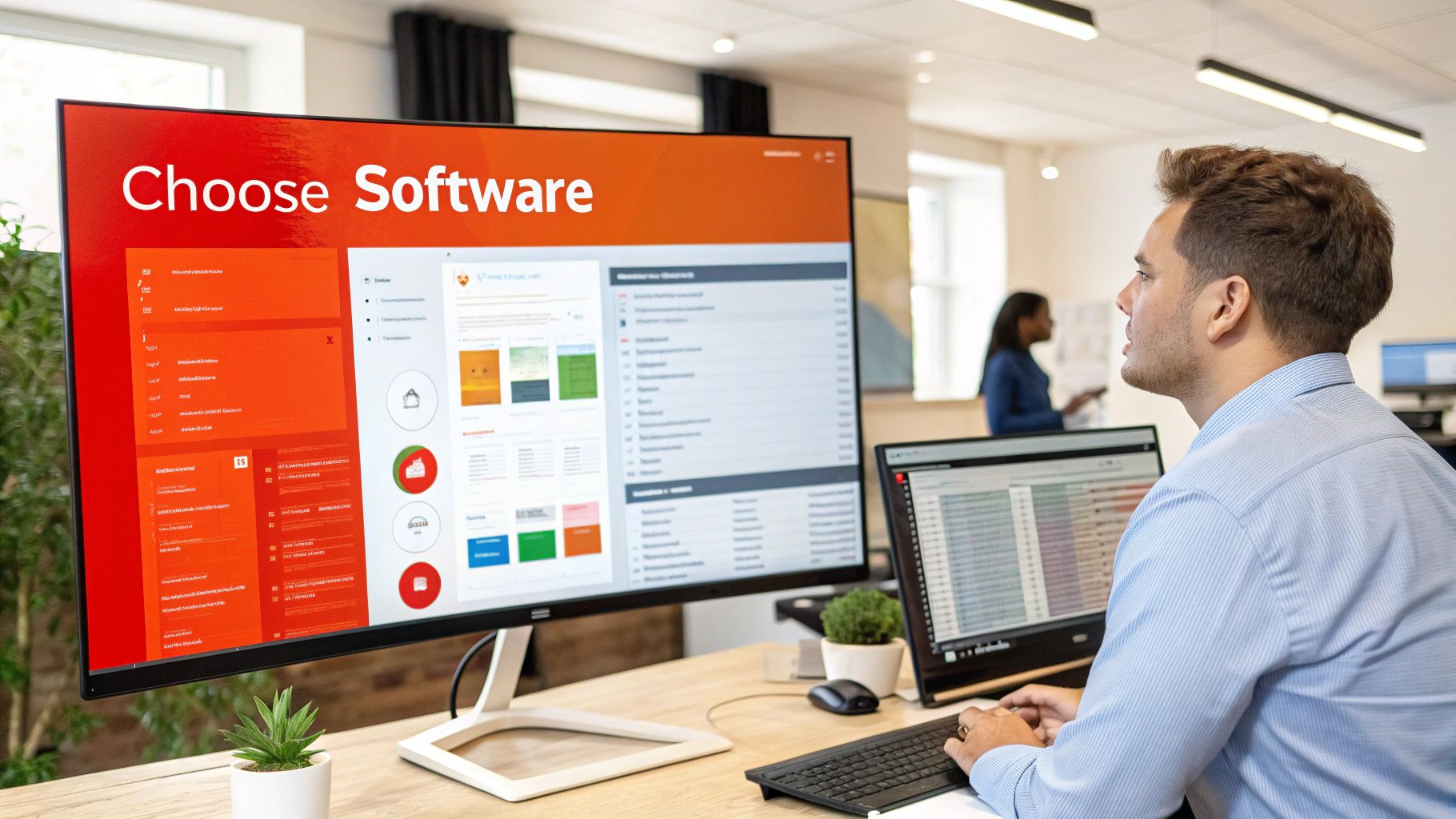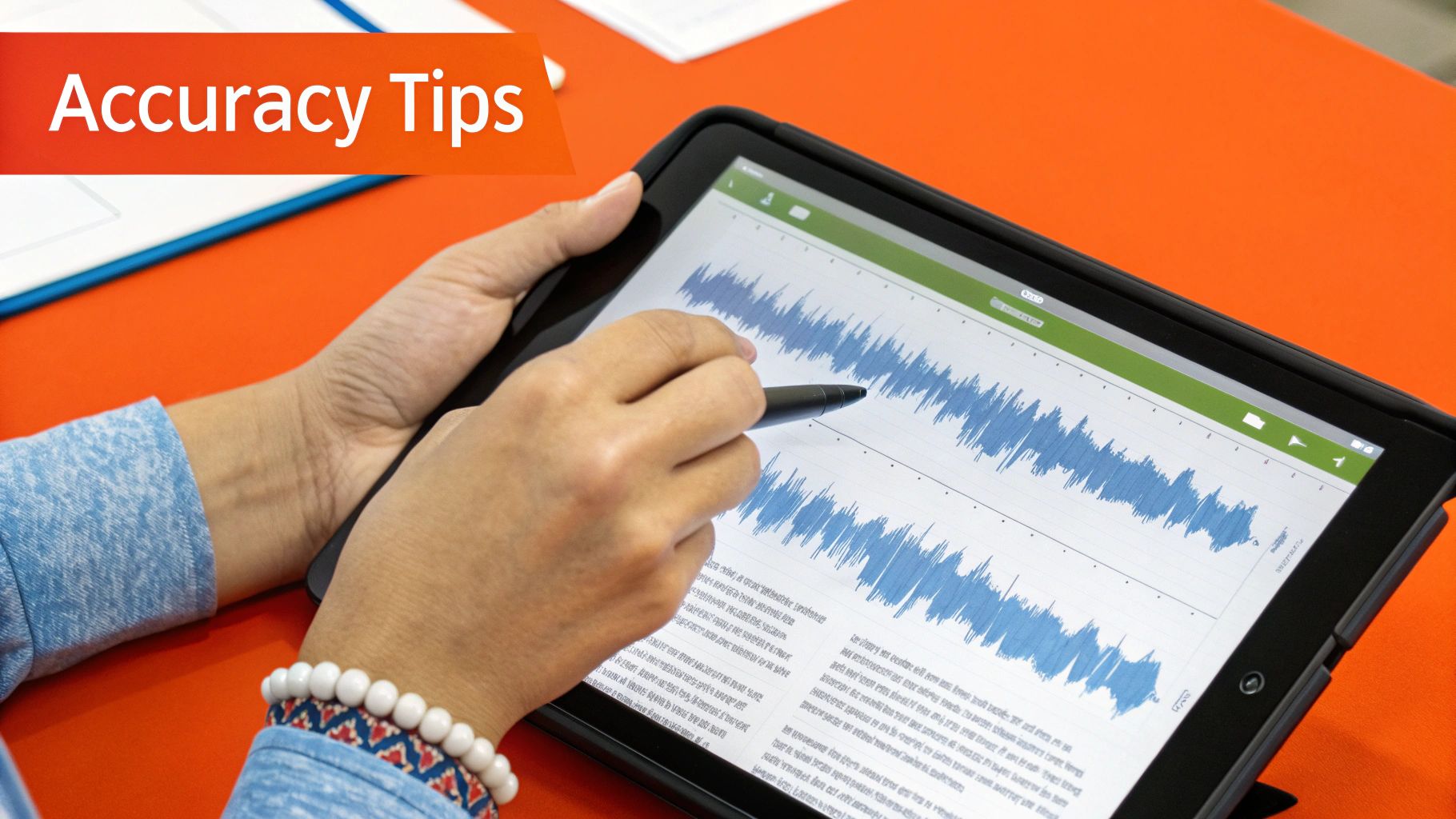Understanding What Makes Audio Transcription Work
Transcribing audio into written text may seem like a straightforward process, but there's a lot more happening behind the scenes than you might think. This transformation involves sophisticated technology and, depending on the chosen method, different levels of human involvement. Let's explore the key elements that make audio transcription possible.
Decoding the Process: Manual vs. Automated vs. Hybrid
There are three primary methods of audio transcription: manual, automated, and hybrid. Manual transcription relies on a human listener who meticulously types out every word they hear. While this offers the highest level of accuracy, it's also the most time-consuming and expensive option. Automated transcription, conversely, leverages speech recognition software, often powered by artificial intelligence (AI) and machine learning. This offers a faster and more cost-effective solution, but the accuracy can fluctuate based on the audio's quality and complexity. Finally, the hybrid approach merges the strengths of both methods. AI handles the initial transcription, which is then reviewed and refined by human transcribers to correct any errors. This combines the speed of automated systems with the precision of human oversight.
Factors Influencing Transcription Accuracy
Several factors play a vital role in the overall success of a transcription project. Speaker clarity is paramount. Mumbling, rapid speech, and strong accents can pose a challenge to both human transcribers and automated systems. Similarly, background noise has a substantial impact on accuracy. Imagine transcribing a conversation recorded in a bustling coffee shop versus one recorded in a quiet studio. The difference in clarity is significant. Furthermore, technical terminology and industry-specific jargon can add another layer of complexity. Specialized vocabulary, especially in fields like medicine or law, requires in-depth knowledge for accurate interpretation.
The Role of Technology and the Market's Growth
The driving force behind automated and hybrid transcription is speech recognition technology. This dynamic and ever-evolving field employs complex algorithms to interpret and translate spoken language into written text. Its continued growth is fueled by the rising demand for efficient and accurate transcription solutions across diverse sectors. In fact, the global speech recognition market—a key component of audio-to-text transcription technology—is projected to reach USD 8.77 billion by 2025 with a significant Compound Annual Growth Rate (CAGR). This technology underpins various transcription services by utilizing AI and machine learning algorithms to convert spoken language into written form. For more detailed market insights, check out Statista.
The Importance of Precision Across Industries
The demand for accurate transcription spans a multitude of industries. In healthcare, precise patient records are essential for accurate diagnoses and treatment planning. Legal proceedings depend on meticulous documentation of testimonies and depositions. Media companies use transcription for subtitles and captions, while businesses rely on it for meeting minutes and internal communication. In each of these instances, the precision and reliability of the transcribed text are crucial for effective communication and well-informed decision-making. This underscores the growing importance of understanding the elements that influence transcription quality and selecting the most suitable approach for each unique need.
Choosing Your Transcription Method Like A Pro
Transcribing audio into text can feel overwhelming, but choosing the right method simplifies the process. Whether you opt for manual, automated, or hybrid transcription, each approach has its own set of pros and cons affecting accuracy, cost, and turnaround time. Understanding these differences allows you to make the best decision for your project.
Manual Transcription: The Gold Standard for Accuracy
Manual transcription relies on human transcribers, offering the highest level of accuracy. These skilled professionals carefully listen to every word, capturing nuances, accents, and complex terminology. This makes manual transcription ideal for situations demanding precision, such as legal depositions, medical dictations, and academic research. However, the process can be time-consuming and more expensive than automated options.
Automated Transcription: Speed and Efficiency at Scale
Automated transcription utilizes AI-powered speech recognition software like Otter.ai to process large volumes of audio quickly and efficiently. This cost-effective method is well-suited for tasks like transcribing meeting minutes, lectures, or podcast episodes. While AI is constantly improving, automated transcription can struggle with audio containing multiple speakers, strong accents, or background noise, potentially leading to errors that require manual review.
Hybrid Transcription: Balancing Accuracy and Speed
The hybrid approach combines the strengths of both manual and automated transcription. AI generates an initial draft, and then human transcribers review and refine the output, correcting any errors and ensuring accuracy, especially in complex audio passages. This balanced approach works well for projects needing both efficiency and high accuracy.
Factors Influencing Your Choice
Several key factors should influence your choice of transcription method. Audio quality is paramount. Clear audio is suitable for automated transcription, while noisy audio benefits from a human ear. Speaker accents and dialects can also affect accuracy, as automated systems may misinterpret unfamiliar pronunciations. For audio containing technical jargon or specialized vocabulary, manual or hybrid transcription often yields better results. Finally, data security requirements, particularly for sensitive information, may dictate your choice.
To help you compare the different methods, let's look at a breakdown of each one. The table below summarizes the key differences between manual, automated, and hybrid transcription:
As you can see, each method has its own set of strengths and weaknesses. While manual transcription offers the highest accuracy, it also comes at the highest cost and longest turnaround time. Automated transcription offers the fastest turnaround and lowest cost but may sacrifice some accuracy. Hybrid transcription aims to find a balance between these factors.

Making the Right Decision
Ultimately, the best transcription method depends on your specific needs. By considering the factors discussed and reviewing the table above, you can choose the approach that offers the best balance of accuracy, speed, and cost. Whether you prioritize speed, accuracy, or a combination of both, understanding the nuances of each method will help you transcribe your audio effectively.
Building Your Professional Transcription Toolkit
The difference between struggling through audio transcription and efficiently completing it often comes down to the tools you use. Think of a skilled carpenter: they can achieve decent results with basic hand tools, but power tools drastically increase both speed and precision. Effective transcription similarly relies on software and hardware that streamlines the process. This section explores the essential components of a professional transcription toolkit, from freeware to industry-standard platforms.
Essential Software Features
When choosing transcription software, certain features are crucial for efficient and accurate results. Variable playback speed control is essential for adjusting to different speaking paces and audio clarity. Foot pedal integration allows hands-free playback control, freeing your hands for typing. Automatic timestamps simplify marking specific points in the audio, vital for many applications. Finally, speaker identification can automatically label different speakers, especially useful for interviews or multi-person meetings.
Software Options: From Free to Professional
Many transcription software options cater to various needs and budgets. oTranscribe is a free, web-based tool with basic functionality, ideal for beginners or occasional transcribers. Express Scribe is a popular desktop application known for its foot pedal support and variable playback speed. For professional-grade transcription, Rev and Otter.ai offer robust features including AI-powered transcription and advanced editing tools. Each option offers a unique balance of features, cost, and ease of use.
Security and Workflow Considerations
For sensitive content, security is paramount. Consider whether cloud-based or desktop solutions better align with your security protocols. Cloud-based solutions offer accessibility and collaboration but may raise confidentiality concerns. Desktop software keeps your data local but may lack collaborative features. Also, think about your workflow. Do you need integration with other software? Do you require collaborative features for team projects? These factors are key in selecting the right tools.
The Growing Importance of Transcription Tools
The right tools aren't just about individual efficiency; they contribute to the transcription industry's growth. This market is experiencing a surge in demand driven by increasing audio and video content. This is reflected in recent market valuations. The U.S. transcription market was valued at approximately USD 30.42 billion in 2024 and is projected to reach USD 41.93 billion by 2030, fueled by the healthcare industry's need for HIPAA-compliant records. Find more detailed statistics here. This growth highlights the importance of professional tools in meeting evolving industry needs.
Hardware Enhancements
While software is central to your transcription toolkit, hardware can significantly improve your workflow. A quality transcription headset with noise-canceling features helps you focus. An ergonomic keyboard reduces strain during long sessions. A foot pedal compatible with your software offers hands-free playback control, boosting efficiency and reducing fatigue. By carefully considering both software and hardware, you can create a toolkit that empowers accurate and efficient transcription.

Mastering Manual Transcription Techniques That Work

Professional transcriptionists are more than just fast typists. They utilize specific techniques to ensure both speed and accuracy. Whether you're a seasoned pro or just beginning, these honed strategies can drastically improve your transcription workflow, allowing you to convert audio to text efficiently and precisely.
Optimizing Your Playback Speed and Finger Positioning
A crucial technique is mastering playback speed control. Counterintuitively, slowing the audio down can improve accuracy, particularly with complex or unclear dialogue. Conversely, a slight speed increase can boost efficiency with clear recordings. Finger positioning is also essential for preventing fatigue during long sessions. Maintain a relaxed hand position and minimize unnecessary finger movements. When selecting transcription software, prioritize helpful features. Tevello offers a robust suite of tools worth exploring.
Handling Challenging Audio
Deciphering challenging audio is another vital skill. This includes audio with multiple speakers, accents, or unclear speech. Active listening, focusing intently on the audio and using context to fill gaps, is key. If a word is mumbled, surrounding words and the conversation's context can often reveal its meaning. Familiarity with diverse accents and speech patterns also significantly improves comprehension.
Workflow and Formatting
Professional transcription follows a structured workflow, beginning with an initial audio assessment. This helps gauge the audio's complexity and anticipate challenges. This assessment informs the transcription process itself, followed by meticulous proofreading. Professional standards dictate guidelines for timestamps, speaker identification, and document formatting, ensuring clarity, consistency, and ease of understanding. Timestamps pinpoint specific moments, while clear speaker identification prevents confusion in multi-person conversations.
Overcoming Common Transcription Obstacles
Obstacles are inevitable, even for experienced transcriptionists. Background noise, technical jargon, and rapid speech can all disrupt the process. However, solutions exist. Noise reduction software minimizes background distractions, while online dictionaries and glossaries can clarify technical terms. Strategies for handling rapid speech, such as keyboard shortcuts or shorthand, can significantly boost efficiency. The marketing transcription market is projected to reach USD 5.64 billion by 2035, highlighting the growing importance of audio-to-text transcription, particularly in marketing strategies. Learn more at Future Market Insights. Mastering these techniques requires practice and patience, but the reward – accurate, efficient, and professional transcripts – is well worth the effort.
Getting Better Results From Automated Transcription
While Artificial Intelligence (AI) has changed audio transcription, consistently accurate results depend on understanding how these systems operate. Instead of fighting the technology's limitations, work with its strengths. Optimize your audio and workflow to improve AI performance.
Understanding Speech Recognition Mechanics
Automated transcription uses speech recognition, which converts spoken language into written text. Complex algorithms analyze audio, identify phonemes (individual sound units), and assemble them into words and sentences. Like human brains, these systems can struggle with unclear speech, background noise, and unfamiliar accents.
Imagine understanding a conversation in a noisy restaurant. The surrounding chatter makes deciphering words difficult. Similarly, AI struggles with background noise in audio. Clear audio is vital for accurate transcription.
Preparing Audio for Optimal Transcription
Preparing your audio before transcribing is crucial for high accuracy. Minimize background noise and maximize speaker clarity. Think of it like preparing ingredients for cooking: better ingredients yield better results.
Here are some practical tips:
- Record in a quiet environment: Minimize background noise for clearer recordings, improving the AI's ability to isolate the speaker's voice.
- Use a quality microphone: A good microphone captures clear audio, reducing distortions and providing a clean signal for processing.
- Position the microphone correctly: Position the microphone close to the speaker (6-12 inches away) to enhance voice clarity and reduce ambient noise.
- Reduce echo and reverberation: Minimize hard surfaces in the recording area to reduce echo and reverberation, which can confuse the AI.
Training for Industry-Specific Terminology
AI transcription systems can learn industry-specific jargon and speaking patterns, improving accuracy with technical or specialized vocabulary. It's like teaching the AI a new language.
Some AI transcription platforms allow custom vocabularies or dictionaries. This lets you add terms or phrases the system might misinterpret. Medical or legal professionals, for example, can add relevant technical terms.
Mastering Post-Processing Techniques
Even with prepared audio and trained systems, post-processing is often needed. Review and edit the transcript to correct errors and ensure accuracy.
Common errors include:
-
Homophones: Words that sound alike but have different meanings (e.g., "there," "their," "they're").
-
Misinterpreted numbers or acronyms: AI can sometimes misinterpret these.
-
Incorrect punctuation: Automated systems may have punctuation errors. An efficient post-processing workflow involves:
-
Using a text editor with find/replace: Quickly locate and correct recurring errors.
-
Listening while reviewing: Ensure accuracy and catch subtle errors.
-
Proofreading carefully: A final proofread catches remaining errors. By following these techniques, you can significantly improve automated transcription accuracy and quality. While AI is constantly evolving, understanding its capabilities and limits helps you use it effectively and get the most out of this technology.
Industry-Specific Strategies That Actually Matter
Generic transcription methods often fall short when it comes to meeting the unique demands of specialized industries. From healthcare to legal, each sector has its own specific terminology, formatting preferences, and compliance regulations. This means a tailored approach is essential when transcribing audio to text. Let's explore how industry-specific strategies can enhance both the accuracy and professionalism of your transcripts.
Healthcare Transcription: Accuracy and HIPAA Compliance
In the healthcare industry, accuracy is paramount. Medical transcription involves converting audio, such as doctor dictations, patient interviews, and other recordings, into written records. These records are essential for patient care, insurance claims, and legal documentation. The terminology used is complex, and even minor inaccuracies can have serious consequences. Furthermore, HIPAA regulations mandate strict patient confidentiality, necessitating secure transcription methods and strict adherence to data privacy protocols. Typical formats include patient history reports, discharge summaries, and operative reports.

Legal Transcription: Precision and Confidentiality
Legal transcription requires precise documentation of legal proceedings, depositions, and client interviews. Accuracy is essential, as these transcripts frequently play a crucial role in legal decisions. Attorney-client privilege and other confidentiality regulations require the secure handling of sensitive information. Verbatim transcription, capturing every spoken word, is often necessary. Common formats include court transcripts, depositions, and legal memorandums.
Media Transcription: Timing and Speaker Identification
Media transcription typically involves transcribing audio or video content for subtitles, captions, and transcripts. Timing is crucial to ensure synchronization between the audio and the written text. Clear speaker identification is also essential, particularly in interviews or multi-person discussions. Media transcription often uses timecodes and speaker labels to improve clarity and navigation.
Education Transcription: Accessibility and Research
Educational institutions use transcription for lectures, research interviews, and student presentations. Transcription improves accessibility for students with disabilities, enhances learning outcomes, and generates valuable research data. Maintaining accuracy is vital for preserving the integrity of academic work. For improved results from automated transcription, AI-powered captions can be a useful tool. Learn more about leveraging AI captions for video. Common formats include lecture transcripts, research interview transcripts, and captioned videos.
Business Transcription: Efficiency and Communication
Businesses utilize transcription for meetings, conference calls, and internal communications. Efficient transcription streamlines communication, improves record-keeping, and facilitates knowledge sharing. While verbatim transcription is sometimes necessary, summarized transcripts are often sufficient for internal use. Accuracy remains important for maintaining clear and effective communication.
Choosing the Right Approach
When transcribing audio to text, it's important to consider the specific needs of your industry. Automated solutions can be cost-effective, but they may not provide the accuracy required for complex fields like healthcare or legal. Manual or hybrid transcription might be necessary when precision is paramount. By understanding the specific demands of each industry, you can select the optimal transcription method to ensure accuracy, efficiency, and compliance.
To help illustrate the varying needs across different sectors, the following table summarizes key requirements and considerations:
Industry Transcription Requirements: Key requirements and considerations for transcription across different industries including accuracy standards, formatting needs, and compliance requirements.
This table provides a helpful overview of industry-specific transcription requirements. Remember to prioritize accuracy, comply with relevant regulations, and tailor your approach to achieve the best results.
Key Takeaways For Transcription Success
Successfully transcribing audio to text involves more than just hitting the play button and typing. It requires a strategic approach, understanding the available methods, and a keen focus on quality control. This section summarizes key takeaways for achieving consistent transcription success, regardless of your specific needs.
Choosing the Right Transcription Method
Selecting the appropriate transcription method is crucial for success. Consider these factors: